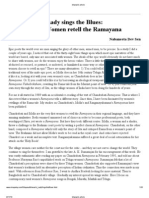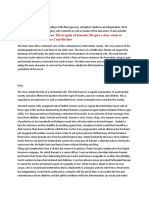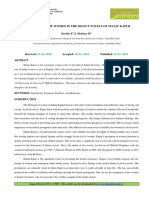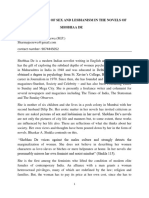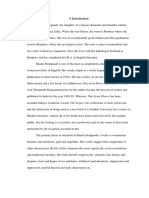The Pattern in The Projection of Working Women in R.K Narayan's The Dark Room and Mr. Sampath
The Pattern in The Projection of Working Women in R.K Narayan's The Dark Room and Mr. Sampath
Uploaded by
IJELS Research JournalCopyright:
Available Formats
The Pattern in The Projection of Working Women in R.K Narayan's The Dark Room and Mr. Sampath
The Pattern in The Projection of Working Women in R.K Narayan's The Dark Room and Mr. Sampath
Uploaded by
IJELS Research JournalOriginal Title
Copyright
Available Formats
Share this document
Did you find this document useful?
Is this content inappropriate?
Copyright:
Available Formats
The Pattern in The Projection of Working Women in R.K Narayan's The Dark Room and Mr. Sampath
The Pattern in The Projection of Working Women in R.K Narayan's The Dark Room and Mr. Sampath
Uploaded by
IJELS Research JournalCopyright:
Available Formats
International Journal of English Literature and Social Sciences
Vol-7, Issue-4; Jul-Aug, 2022
Journal Home Page Available: https://ijels.com/
Journal DOI: 10.22161/ijels
The Pattern in the Projection of Working Women in R.K
Narayan’s The Dark Room and Mr. Sampath
Jyoti Kumari
Department of English, Central University of Himachal Pradesh, Dharamshala, India.
Email. Jyotichau56@gmail.com
Received: 31 Jul 2022; Received in revised form: 20 Aug 2022; Accepted: 25 Aug 2022; Available online: 31 Aug 2022
©2022 The Author(s). Published by Infogain Publication. This is an open access article under the CC BY license
(https://creativecommons.org/licenses/by/4.0/).
Abstract— Working women is not a recent phenomenon but in India they still face a bias and prejudice
against them. This prejudice and stereotyping can also be traced into the works of literature. This paper
aims to analyze the depiction of some of the working women’s characters in the early Indian English
novels by R.K Narayan. It will try to throw light on the patriarchal ideology in the narration and projection
of working women’s characters in the select novels. How women are often put under certain labels which
work for patriarchy and specifically working women who do not conform to this ideology, have to face
more social prejudices. This paper will examine these biased patterns which are prevalent in RK
Narayan’s select novels. It will showcase how a working woman is perceived by the society and also how
the writer deals with these patriarchal ideologies.
Keywords— Family, Indian English Fiction, Patriarchy, Working Women, Workspace.
I. INTRODUCTION A working woman according to thefreedictionary.com is a
R.K Narayan is one of the most celebrated and widely woman who earns a salary, income or regular wages by
read writers of India. He is known for his stories set in getting herself employed outside her home. Women face
fictional town of Malgudi. His writing style has a societal and traditional restrictions to work in India. Even
simplicity and a humor. This paper will view the in 21st century relatively very few women are able to find
representation of working women in two of his novels, work (Flecher 3). Udit Mishra in his article, “India is no
namely The Dark Room and Mr. Sampath. The Dark Room Country for Working Women. Here’s Why” says that India
is a story about a traditional Indian Hindu wife, Savitri. is a conservative society with orthodox beliefs and
The novel portrays that how the conjugal relationship practices violence against women. And this leads to
between Savitri and Ramani becomes tensed when Ramani women’s low participation rates in the labour force.
gets into an extra marital affair with one of his co-workers According to the World Bank data for 2019, India has one
Shanta Bai. Shanta Bai is the working woman in this novel of the lowest female participation rates in the world at 21%
whose character will be analyzed. according to World Bank LFPR (Labour Force
Participation Rate). This figure is not even the half of the
Mr. Sampath is a story about a writer, Srinivas and his
worldwide average of 47%.
friend Mr. Sampath who was a publisher and later got into
a movie business. The story follows how Mr. Sampath This paper purposes to examine the patriarchal ideologies
ruins his business and his marital relationship because of against working women present in these texts. And how
his indulgence into an extramarital affair with Shanti, the these ideologies shape the representation of working
lead actress of the movie. Shanti is the subject of analysis women in literature.
in this novel.
IJELS-2022, 7(4), (ISSN: 2456-7620)
https://dx.doi.org/10.22161/ijels.74.46 311
Kumari et al. The Pattern in the Projection of Working Women in R.K Narayan’s The Dark Room and Mr. Sampath
II. DISCUSSION their affair but Ramani defends himself through the
There is a prominent pattern in the projection of these narration of the novel. But she has no direct encounter with
women’s characters concerning their family backgrounds, the readers. She is at a distance and presented as a third
moral values and working capabilities. Shanta Bai was person about whom readers get to know from other
married to one of her cousins who was a drunkard so she characters or the omniscient narrator. Shanta Bai’s
left him and pursued her studies. She does not have any character does not speak like other major character speak
family. After getting the job she lives alone in the office. for themselves in the novel.
She does not show any concern about taking care or 2.2 Mr. Sampath
nursing the kids. She does not follow the traditional norms Shanti is an actress in the novel Mr. Sampath. She has
for women as wives. She does not uphold any moral values been chosen for the role because of her beautiful face and
as she gets into an affair with a married man. Shanti in Mr. not for her acting abilities. As Mr. Sampath says at the
Sampath also has same kind of character. She also lives time of her appointment, “Of course; we can call her up.
alone. Her family is not mentioned. She is a widow. She Her face struck me as the most feasible type for Parvati”
also gets into an illegitimate affair with Mr. Sampath. (Narayan 127). She comes late for the rehearsal as
2.1 The Dark Room Sampath tells that she takes extra three hours to get
The representation of working women in their work spaces dressed up. It represents her unprofessional nature and her
is also biased. Shanta Bai is represented as amateurish and obsession with her beauty without any concern for her
not even ready to learn. She is seen as nuisance in the work. She has been married to a forest officer but she got
office by other male workers. The patriarchal ideology separated and later became a widow also. She also has a
prevalent in the Engladia Insurance Company in the novel kid, whom she has left with some of her relatives as the
can be seen when company advertises to take women to readers come to know later in the novel. Sampath tells
train in office and field to assist insurance policies on everyone that he and Shanti are cousins but they were
female lives. The employees joke about how women’s indulged in an affair. Sampath wants to marry her. She
applications are for harem. As the accountant Kataiengar becomes a distraction to one of the characters, Ravi in the
says, “A nice treat the boss has arranged. You can have novel. Ravi tries to molest her on the sets during the shoot.
your pick for the harem between fifteenth and the This also shows the violence which women face in their
twentieth. Don’t miss the office at any account” (Narayan workspaces. This incident leads to the devastation of the
48). He further asks, “Do they want to convert the film as well as the set. Shanti was so depressed that
company into a brothel?” (Narayan 49). It shows how Sampath takes her to Mempi hills for a rest. But Sampath
women and their profession is perceived by the male finds it hard to live with her fits and hysteric temperament.
counterparts. Women are viewed as sex objects only. As he puts it, “Well I didn’t much mind her physical
Shanta is a beautiful woman who has left her husband as condition. It was her temperament that disgusted me. She
he was a drunkard. She is referred as houri, fairy, fresh was quarrelsome, nagging…. wouldn’t leave me in peace.”
rose and “something to relieve the drabness” in the office (Narayan 214). Her personality is described as awful and a
by her co-workers. As she joins the office other employees kind with which a man cannot live.
feel distracted by her presence itself. Shanta Bai has been
appointed to the post with the recommendation of Ramani, III. CONCLUSION
so he expects a thanks from Shanta for his
To conclude the nature of representation of the working
recommendation and also for, he arranged a room for her.
women by RK Narayan in these novels, there are some
But instead she was dissatisfied by her salary. She was
basic similarities between these two characters named
portrayed as an overambitious and a thankless person.
Shanta Bai and Shanti which come forward. Their
Shanta Bai has been given a month to show progress but as
character attributes, family background and their morals
the narrator tells, “Shanta Bai had been in the office for a
are similar to each other. They come from parallel
month and yet she exhibited no aptitude for canvassing
background and also come across as similar to each other.
work” (Narayan 66). Instead, she develops an illegitimate
Both of the characters have broken marriages, they are ill
affair with Ramani to progress in her job. This leads to yet
tempered and incompetent for the assigned jobs. In both of
another stereotype against working women that they use
the novels RK Narayan has not given them space to narrate
men to progress and not their abilities and skills. She is
their side or to defend themselves against these
represented as a very temperamental person. She shows
projections. This representation leads to the stereotypical
tantrums and puts on acts of breakdown to gain sympathy.
and a biased image of working women in these novels. It
Ramani and Shanta Bai both were equally responsible for
stereotypes that working women are incapable of having a
IJELS-2022, 7(4), (ISSN: 2456-7620)
https://dx.doi.org/10.22161/ijels.74.46 312
Kumari et al. The Pattern in the Projection of Working Women in R.K Narayan’s The Dark Room and Mr. Sampath
successful marriage, can not and do not want to take care
of their kids and not at all family oriented. They do not
adhere to the moral codes of the society in order to climb
the ladder of success. It forms a rift between a traditional
Indian woman who holds her morality high and a family-
oriented person and a working woman who has none of
these specific features of an Indian woman.
REFERENCES
[1] Flecher, Erin K. et.al. (2017). “Women and Work in India:
Descriptive Evidence and a Review of Potential Policies.”
CID Working Papers Series, 339, Harvard University,
Cambridge.
[2] Narayan, RK. (2013). The Dark Room. Indian Thought
Publications.
[3] … . (2009). Mr. Sampath. Indian Thought Publications.
IJELS-2022, 7(4), (ISSN: 2456-7620)
https://dx.doi.org/10.22161/ijels.74.46 313
You might also like
- Deshpande's That Long Silence FinalDocument76 pagesDeshpande's That Long Silence Finalkulveer50% (2)
- Chandrabati Ramayana Du English GeDocument5 pagesChandrabati Ramayana Du English GeheretostudyNo ratings yet
- Nabaneeta Dev Sen - When Women Retell The Ramayana - Manushi ArticleDocument16 pagesNabaneeta Dev Sen - When Women Retell The Ramayana - Manushi Articletvphile131475% (8)
- Book Review of The Dark Room by R.K. NarayanDocument4 pagesBook Review of The Dark Room by R.K. NarayanVaibhav67% (3)
- RK Narayan's The Dark Room: Kumar MadarDocument5 pagesRK Narayan's The Dark Room: Kumar MadarDolly KushwahaNo ratings yet
- Portrayal of Women in The Writings of R.K. Narayan: Hemaadri Singh RanaDocument8 pagesPortrayal of Women in The Writings of R.K. Narayan: Hemaadri Singh Ranaakhand kishoreNo ratings yet
- Shanti of Mr. Sampath and Rangi of The Man Easter of Malgudi Add Spice To The Novels ofDocument4 pagesShanti of Mr. Sampath and Rangi of The Man Easter of Malgudi Add Spice To The Novels ofIshani BanerjeeNo ratings yet
- JETIR1906B81Document3 pagesJETIR1906B81Shreya SuryavanshiNo ratings yet
- ENGA SEM II (GUIDE) ARTICLE 1 - SrijitaDocument45 pagesENGA SEM II (GUIDE) ARTICLE 1 - SrijitaShubhadipNo ratings yet
- Analysis of The Character of Savitri in The Dark Room: Rushika GillDocument6 pagesAnalysis of The Character of Savitri in The Dark Room: Rushika GillTJPRC PublicationsNo ratings yet
- Portrayal of Women in R. K. Narayan'S The DarkDocument4 pagesPortrayal of Women in R. K. Narayan'S The Darkakhand kishoreNo ratings yet
- Ijrar Issue 1956Document6 pagesIjrar Issue 1956MOUMITA MOKNDALNo ratings yet
- The Portrayal of Women in The Select Novels of Manju Kapur-2018-11!24!11-31Document4 pagesThe Portrayal of Women in The Select Novels of Manju Kapur-2018-11!24!11-31Impact JournalsNo ratings yet
- KanthapuraDocument2 pagesKanthapuraitsanaisikthingNo ratings yet
- Yagjnaseni - Feminest PrinciplesDocument8 pagesYagjnaseni - Feminest PrinciplesRamanasarmaNo ratings yet
- Feminism and Indian WomenDocument7 pagesFeminism and Indian WomenRavan KhatalNo ratings yet
- The Painter of SignsDocument6 pagesThe Painter of SignsRupesh ChauhanNo ratings yet
- Unit 3Document12 pagesUnit 3Tanvi SharmaNo ratings yet
- Feminism in Anita Nair's Lessons in Forgetting by P.Subashini, Govindammal Aditanar College For Women, Tiruchendur.Document5 pagesFeminism in Anita Nair's Lessons in Forgetting by P.Subashini, Govindammal Aditanar College For Women, Tiruchendur.subashinipattan100% (1)
- Intru - Self Effacing WomanDocument5 pagesIntru - Self Effacing Womannamrutha.2022.689No ratings yet
- Sharma JiDocument13 pagesSharma JiVir Mehta100% (1)
- That Long Silence - WPS OfficeDocument3 pagesThat Long Silence - WPS OfficeJyoti MishraNo ratings yet
- Nectar in A Sieve and The Role of WomenDocument2 pagesNectar in A Sieve and The Role of WomensasNo ratings yet
- Custody PDFDocument6 pagesCustody PDFDushyant NimavatNo ratings yet
- Images of Women in Namitha Gokhale's WorksDocument5 pagesImages of Women in Namitha Gokhale's WorksEditor IJTSRDNo ratings yet
- Research PaperDocument8 pagesResearch PaperPankaj soniNo ratings yet
- Ijll. Narrative Technique - 2Document8 pagesIjll. Narrative Technique - 2iaset123No ratings yet
- 07 Chapter 3Document30 pages07 Chapter 3Ishani BanerjeeNo ratings yet
- Sblvaji Ur - WBV, Kwlhapur.: NR R IDocument29 pagesSblvaji Ur - WBV, Kwlhapur.: NR R IShahruk KhanNo ratings yet
- Wa0001.Document5 pagesWa0001.Nisha YadavNo ratings yet
- Book Review MY DAYS PDFDocument4 pagesBook Review MY DAYS PDFVivek rathodNo ratings yet
- Samskara 2Document6 pagesSamskara 2Janu DaimariNo ratings yet
- Kanthapura 3Document10 pagesKanthapura 3Sanjay SorenNo ratings yet
- Marital Discard in Nayantara Sahgal's The Day in ShadowDocument3 pagesMarital Discard in Nayantara Sahgal's The Day in ShadowSudhaNo ratings yet
- The Conflict Between Tradition and Modernity, R.K. Narayan's - The GuideDocument4 pagesThe Conflict Between Tradition and Modernity, R.K. Narayan's - The GuideShubhadipNo ratings yet
- From Emancipation To Silent Submission: A Study of Some of The Prominent Female Characters of Ruth Prawer JhabvalaDocument4 pagesFrom Emancipation To Silent Submission: A Study of Some of The Prominent Female Characters of Ruth Prawer JhabvalaIJELS Research JournalNo ratings yet
- Balivada Kanta RaoDocument6 pagesBalivada Kanta RaoSrinivasa Rao ReddyNo ratings yet
- RKNarayan TheGuideDocument8 pagesRKNarayan TheGuideJoshi DrcpNo ratings yet
- B-4Unit 1Document12 pagesB-4Unit 1Ratnadip DasguptaNo ratings yet
- Title: Silence! The Court Is in SessionDocument24 pagesTitle: Silence! The Court Is in SessionAnupama PradhanNo ratings yet
- Fire FilmDocument2 pagesFire FilmMadakari NayakaNo ratings yet
- 35.RJOE Siddharth (292 298)Document7 pages35.RJOE Siddharth (292 298)lisaqueens1324No ratings yet
- Transformation of Rani and Her Emerging IdentityDocument9 pagesTransformation of Rani and Her Emerging IdentitySneha PradhanNo ratings yet
- Literature Review On R K NarayanDocument35 pagesLiterature Review On R K NarayanShishir Barik100% (1)
- Shurpanagha A Myth RetoldDocument5 pagesShurpanagha A Myth Retoldmeenaxi motwaniNo ratings yet
- Godan by PremchandDocument4 pagesGodan by Premchandkeval121220No ratings yet
- Submissive and Rebellious Women: A Study of Nayantara Sahgal's Select NovelsDocument2 pagesSubmissive and Rebellious Women: A Study of Nayantara Sahgal's Select NovelsSudhaNo ratings yet
- NogoxegilDocument2 pagesNogoxegilVidya RNo ratings yet
- Anuradha Ghodke & DR Vinay Bhogle PDFDocument5 pagesAnuradha Ghodke & DR Vinay Bhogle PDF123prayerNo ratings yet
- 74 Bijender Singh PDFDocument6 pages74 Bijender Singh PDFRam Sajjan SinghNo ratings yet
- A Thematic Analysis of TheDocument6 pagesA Thematic Analysis of ThepiusNo ratings yet
- Chapter PageDocument43 pagesChapter PageAbhishek DiwakerNo ratings yet
- Shashi Deshpande BackgroundDocument14 pagesShashi Deshpande BackgroundYashrajsingh GiriNo ratings yet
- Exploration of Patriarchy With Reference To The Woman Characters in R.K. Narayan's Novel The GuideDocument4 pagesExploration of Patriarchy With Reference To The Woman Characters in R.K. Narayan's Novel The GuideIjahss JournalNo ratings yet
- Anti Feminist Kannada NovelDocument6 pagesAnti Feminist Kannada NovelB V Rama PrasadNo ratings yet
- The Dark Lord of The Dark Room: DR Shraddha AshapureDocument6 pagesThe Dark Lord of The Dark Room: DR Shraddha AshapureTJPRC PublicationsNo ratings yet
- Human Relationships in Shobhaa De’s NovelsFrom EverandHuman Relationships in Shobhaa De’s NovelsNo ratings yet
- Does Feminism Support Infidelity?: Through The Novels of Manju Kapur with Special Emphasis on Home and a Married WomanFrom EverandDoes Feminism Support Infidelity?: Through The Novels of Manju Kapur with Special Emphasis on Home and a Married WomanNo ratings yet
- Dissident Self-Writing in Malayalam: Reading Autobiographical Dissonance As ProtestDocument6 pagesDissident Self-Writing in Malayalam: Reading Autobiographical Dissonance As ProtestIJELS Research JournalNo ratings yet
- The Theme of Escape': Intertextuality and Compositional Contrast in Somerset Maugham's Selected Short StoriesDocument5 pagesThe Theme of Escape': Intertextuality and Compositional Contrast in Somerset Maugham's Selected Short StoriesIJELS Research JournalNo ratings yet
- Aesthetics of Postcoloniality: An Insight Into Town Planning and Architectural Practices of Madras Under The Colonial RuleDocument9 pagesAesthetics of Postcoloniality: An Insight Into Town Planning and Architectural Practices of Madras Under The Colonial RuleIJELS Research JournalNo ratings yet
- Theatre and Socio-Cultural Aspects in The Novels of Badal SircarDocument7 pagesTheatre and Socio-Cultural Aspects in The Novels of Badal SircarIJELS Research JournalNo ratings yet
- Stoicism: Portrayal of Women in Khamosh Pani, Pinjar and Eho Hamara JeevnaDocument4 pagesStoicism: Portrayal of Women in Khamosh Pani, Pinjar and Eho Hamara JeevnaIJELS Research Journal100% (1)
- Indicting Frost For Androcentric Speciesism: An Ecofeminist Reading of Robert Frost's "The Most of It"Document11 pagesIndicting Frost For Androcentric Speciesism: An Ecofeminist Reading of Robert Frost's "The Most of It"IJELS Research JournalNo ratings yet
- Study of The Impact of Sino-US Trade Friction On Oil PricesDocument12 pagesStudy of The Impact of Sino-US Trade Friction On Oil PricesIJELS Research JournalNo ratings yet
- From Hegemony To Inclusivity: Perspectives On Models of Masculinity by R.W. Connell and Greg AndersonDocument6 pagesFrom Hegemony To Inclusivity: Perspectives On Models of Masculinity by R.W. Connell and Greg AndersonIJELS Research JournalNo ratings yet
- Relevance of Indian Knowledge Systems For Nation and Character BuildingDocument5 pagesRelevance of Indian Knowledge Systems For Nation and Character BuildingIJELS Research JournalNo ratings yet
- Depiction of Women's Oppression in Shashi Despande's That Long SilenceDocument7 pagesDepiction of Women's Oppression in Shashi Despande's That Long SilenceIJELS Research JournalNo ratings yet
- Moroccan EFL Teachers' Perceptions Towards The Use of Authentic Materials To Improve Students' Reading SkillDocument9 pagesMoroccan EFL Teachers' Perceptions Towards The Use of Authentic Materials To Improve Students' Reading SkillIJELS Research JournalNo ratings yet
- An Ecofeminist Approach To Alice Walker's The Color PurpleDocument3 pagesAn Ecofeminist Approach To Alice Walker's The Color PurpleIJELS Research JournalNo ratings yet
- Visualizing The "Shadow" and The "Ghost": Re-Evaluating J.M Coetzee's Foe Through The Lens of Psychoanalysis and PostcolonialismDocument5 pagesVisualizing The "Shadow" and The "Ghost": Re-Evaluating J.M Coetzee's Foe Through The Lens of Psychoanalysis and PostcolonialismIJELS Research JournalNo ratings yet
- Trending Scenario of Teaching Method in The Modern EducationDocument5 pagesTrending Scenario of Teaching Method in The Modern EducationIJELS Research JournalNo ratings yet
- Amitav Ghosh: Engendering The Language of DreamsDocument9 pagesAmitav Ghosh: Engendering The Language of DreamsIJELS Research JournalNo ratings yet
- Implementing Dalcroze's Eurhythmics in Classical Music Appreciation Courses For Young LearnersDocument6 pagesImplementing Dalcroze's Eurhythmics in Classical Music Appreciation Courses For Young LearnersIJELS Research JournalNo ratings yet
- Strout's Insight Into The Times: Trauma and Recovery in Olive KitteridgeDocument9 pagesStrout's Insight Into The Times: Trauma and Recovery in Olive KitteridgeIJELS Research JournalNo ratings yet
- The Interaction Between Terminology and Translation or Where Terminology and Translation MeetDocument2 pagesThe Interaction Between Terminology and Translation or Where Terminology and Translation MeetIJELS Research JournalNo ratings yet
- A Narratological Study of Kamala Markandaya's Two Virgins: Interpreting Narratives Through Saroja's Focalized ViewDocument6 pagesA Narratological Study of Kamala Markandaya's Two Virgins: Interpreting Narratives Through Saroja's Focalized ViewIJELS Research JournalNo ratings yet
- Christian's Struggle and Quest For Spiritualism in John Bunyan's Pilgrims' ProgressDocument3 pagesChristian's Struggle and Quest For Spiritualism in John Bunyan's Pilgrims' ProgressIJELS Research JournalNo ratings yet
- Effectiveness of Contextualized Micro-Lessons in The Acquisition of College English VocabularyDocument6 pagesEffectiveness of Contextualized Micro-Lessons in The Acquisition of College English VocabularyIJELS Research JournalNo ratings yet
- The Empowered Pen: The Enduring Contribution of Women Writers in Indian LiteratureDocument4 pagesThe Empowered Pen: The Enduring Contribution of Women Writers in Indian LiteratureIJELS Research JournalNo ratings yet
- Gender Equality As A Tool For Sustainable DevelopmentDocument3 pagesGender Equality As A Tool For Sustainable DevelopmentIJELS Research JournalNo ratings yet
- Analysis of Grammar ActivitiesDocument3 pagesAnalysis of Grammar ActivitiesIJELS Research JournalNo ratings yet
- "But, Human Is All I Am": Exploration of Posthuman Feminism and (Dis) Embodiment in The Short Story of Vandana SinghDocument5 pages"But, Human Is All I Am": Exploration of Posthuman Feminism and (Dis) Embodiment in The Short Story of Vandana SinghIJELS Research JournalNo ratings yet
- EFL Adult Learners' Perception of Learning English Vocabulary Through Pictures at A Private English CenterDocument8 pagesEFL Adult Learners' Perception of Learning English Vocabulary Through Pictures at A Private English CenterIJELS Research JournalNo ratings yet
- Climatic Change Leads To Global Warming? A Semiotic Analysis of The Kwality Wall's AdvertisementDocument5 pagesClimatic Change Leads To Global Warming? A Semiotic Analysis of The Kwality Wall's AdvertisementIJELS Research JournalNo ratings yet
- Unravelling Marginality and Masculinity: Exploring The Interplay of Gender and Power in Gabriel Garcia Marquez's Chronicle of A Death ForetoldDocument4 pagesUnravelling Marginality and Masculinity: Exploring The Interplay of Gender and Power in Gabriel Garcia Marquez's Chronicle of A Death ForetoldIJELS Research Journal100% (1)
- Advantages and Disadvantages of Using Visual Storytelling To Teach English Vocabulary To Young Learners at Viet Anh Primary SchoolDocument9 pagesAdvantages and Disadvantages of Using Visual Storytelling To Teach English Vocabulary To Young Learners at Viet Anh Primary SchoolIJELS Research Journal100% (1)
- Pride and Prejudice Adaptations: A Comparative StudyDocument5 pagesPride and Prejudice Adaptations: A Comparative StudyIJELS Research JournalNo ratings yet
- S E S S I O N G U I D E Bryan Summative AssessmentDocument7 pagesS E S S I O N G U I D E Bryan Summative AssessmentJohnNo ratings yet
- Building Seismic Design v1.0Document1 pageBuilding Seismic Design v1.0SA023No ratings yet
- Vikas Yadav Akanksha Jain Deepti Dabar Akhil Dhanesh Goel Akanksha Sood Ankur Joshi Sanjay S. Agarwal Sunil Nandeshwar (2021)Document8 pagesVikas Yadav Akanksha Jain Deepti Dabar Akhil Dhanesh Goel Akanksha Sood Ankur Joshi Sanjay S. Agarwal Sunil Nandeshwar (2021)Adamastor MessiasNo ratings yet
- Technical Paper On DesignDocument8 pagesTechnical Paper On DesignTunnel BhauNo ratings yet
- 5-Ampacity Calculation-23-01-2024Document34 pages5-Ampacity Calculation-23-01-2024SarthNo ratings yet
- Classical Statistics and Quantum StatisticsDocument12 pagesClassical Statistics and Quantum StatisticsGayathri Shunmugiah100% (1)
- MP OB Session 3Document31 pagesMP OB Session 3Shubham GoyalNo ratings yet
- WCO Implementation Plan 2024 2025Document14 pagesWCO Implementation Plan 2024 2025K60 NGUYỄN THỊ HƯƠNG QUỲNHNo ratings yet
- Economics of Tobacco in India - A Barrier in Curbing The Silent Epidemic A Comprehensive ReviewDocument7 pagesEconomics of Tobacco in India - A Barrier in Curbing The Silent Epidemic A Comprehensive ReviewInternational Journal of Innovative Science and Research TechnologyNo ratings yet
- Intermediate Pistol Marksmanship Course PoiDocument7 pagesIntermediate Pistol Marksmanship Course PoiDennis VillanuevaNo ratings yet
- Ad90 PDFDocument4 pagesAd90 PDFMuhammad Eitch-BeeNo ratings yet
- Fanatisme Dan Perilaku Agresif Verbal Di Media Sos PDFDocument26 pagesFanatisme Dan Perilaku Agresif Verbal Di Media Sos PDFraniaNo ratings yet
- These Adjectives Are Exceptions To The Rule. What Are Their Comparative and Superlative Forms?Document4 pagesThese Adjectives Are Exceptions To The Rule. What Are Their Comparative and Superlative Forms?Hugo Jhovany Hernandez MorenoNo ratings yet
- ECS Korry QS 389 6pin D41861Document4 pagesECS Korry QS 389 6pin D41861Peter BirdNo ratings yet
- MB Powertrain ExternalSales Bus Classic 0919Document28 pagesMB Powertrain ExternalSales Bus Classic 0919camilo castroNo ratings yet
- Architectural Design Thesis Topics ListDocument7 pagesArchitectural Design Thesis Topics Listpuzinasymyf3100% (2)
- The Modern Alpha Male - Patrick KingDocument55 pagesThe Modern Alpha Male - Patrick KingCoolSimple50% (2)
- 4 - Prof. Gangotri ChakravortyDocument11 pages4 - Prof. Gangotri ChakravortyHitesh RathoreNo ratings yet
- Tempo Valve by UPVCDocument4 pagesTempo Valve by UPVCwisawes.thaiNo ratings yet
- Types of CommunicationDocument22 pagesTypes of Communicationvivekpatel70001No ratings yet
- WTE162 Chapter 1 Introduction To Wood PropertiesDocument22 pagesWTE162 Chapter 1 Introduction To Wood PropertiesHuzairee IsmailNo ratings yet
- TE24EX1 - Rev.03 Product Scopes Vs Rev.04 Scope Families - EN - Rev00Document4 pagesTE24EX1 - Rev.03 Product Scopes Vs Rev.04 Scope Families - EN - Rev00sankusi_rkflNo ratings yet
- (Download PDF) Measuring Research What Everyone Needs To Know 1St Edition Cassidy R Sugimoto Online Ebook All Chapter PDFDocument42 pages(Download PDF) Measuring Research What Everyone Needs To Know 1St Edition Cassidy R Sugimoto Online Ebook All Chapter PDFbrian.ashland164100% (25)
- DOMS Indicador de EFECTIVIDADDocument12 pagesDOMS Indicador de EFECTIVIDADNicolás ManonniNo ratings yet
- Water RochetDocument33 pagesWater RochetDerara UmetaNo ratings yet
- Kinematic Graphs SolvedDocument10 pagesKinematic Graphs SolvedMaria francesca LatiniNo ratings yet
- pp2402 Marine Series 65 Base Mounted Uv Flame Detector Ig Issue 2-LockedDocument4 pagespp2402 Marine Series 65 Base Mounted Uv Flame Detector Ig Issue 2-LockedhalrbrahmeNo ratings yet
- Experiment 4 Soil Mech - CCDocument7 pagesExperiment 4 Soil Mech - CCEl Mera paniaNo ratings yet
- Multiply and Divide Decimals in Context: © White Rose Maths 2022Document2 pagesMultiply and Divide Decimals in Context: © White Rose Maths 2022amtul mouizNo ratings yet


